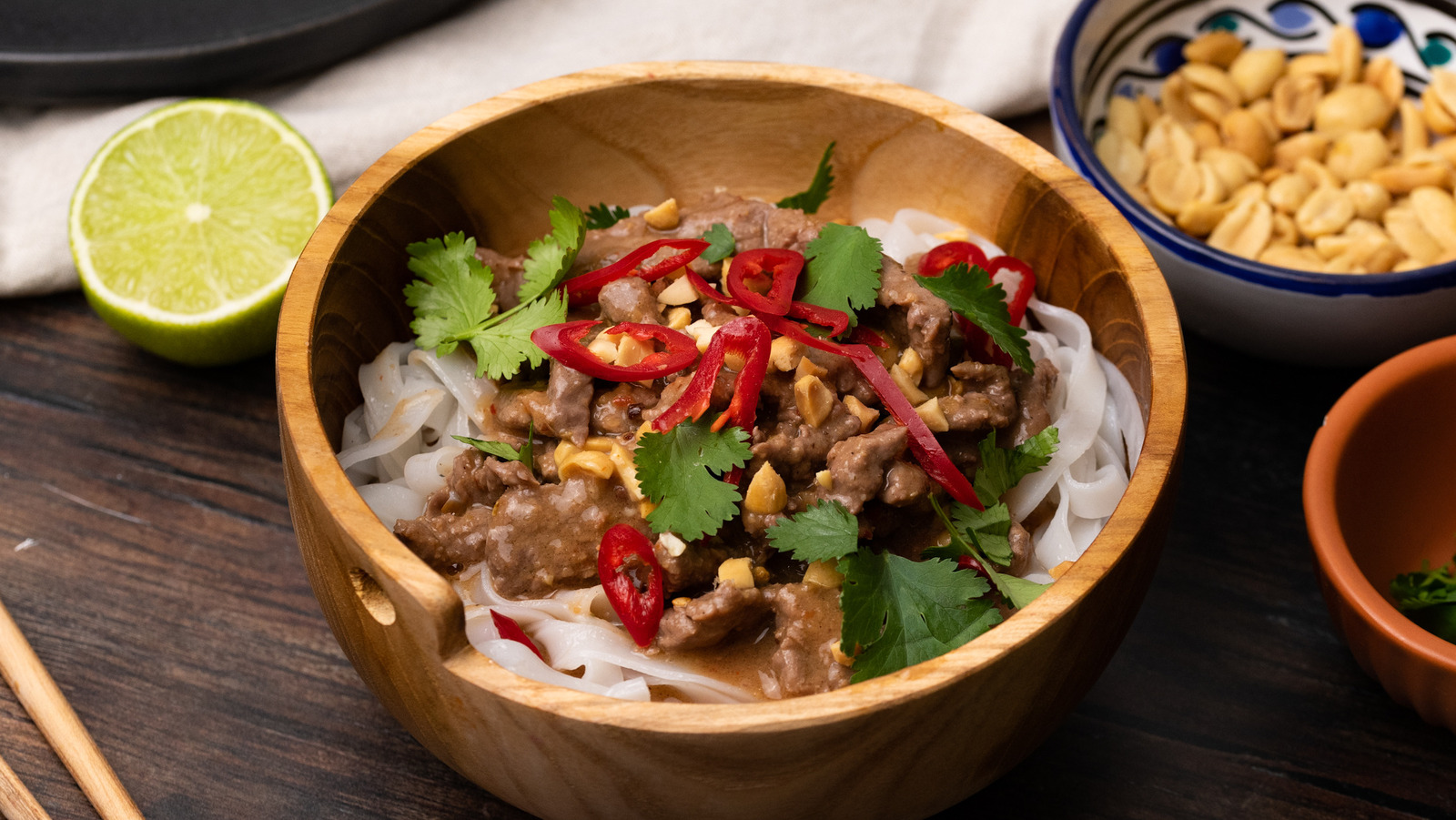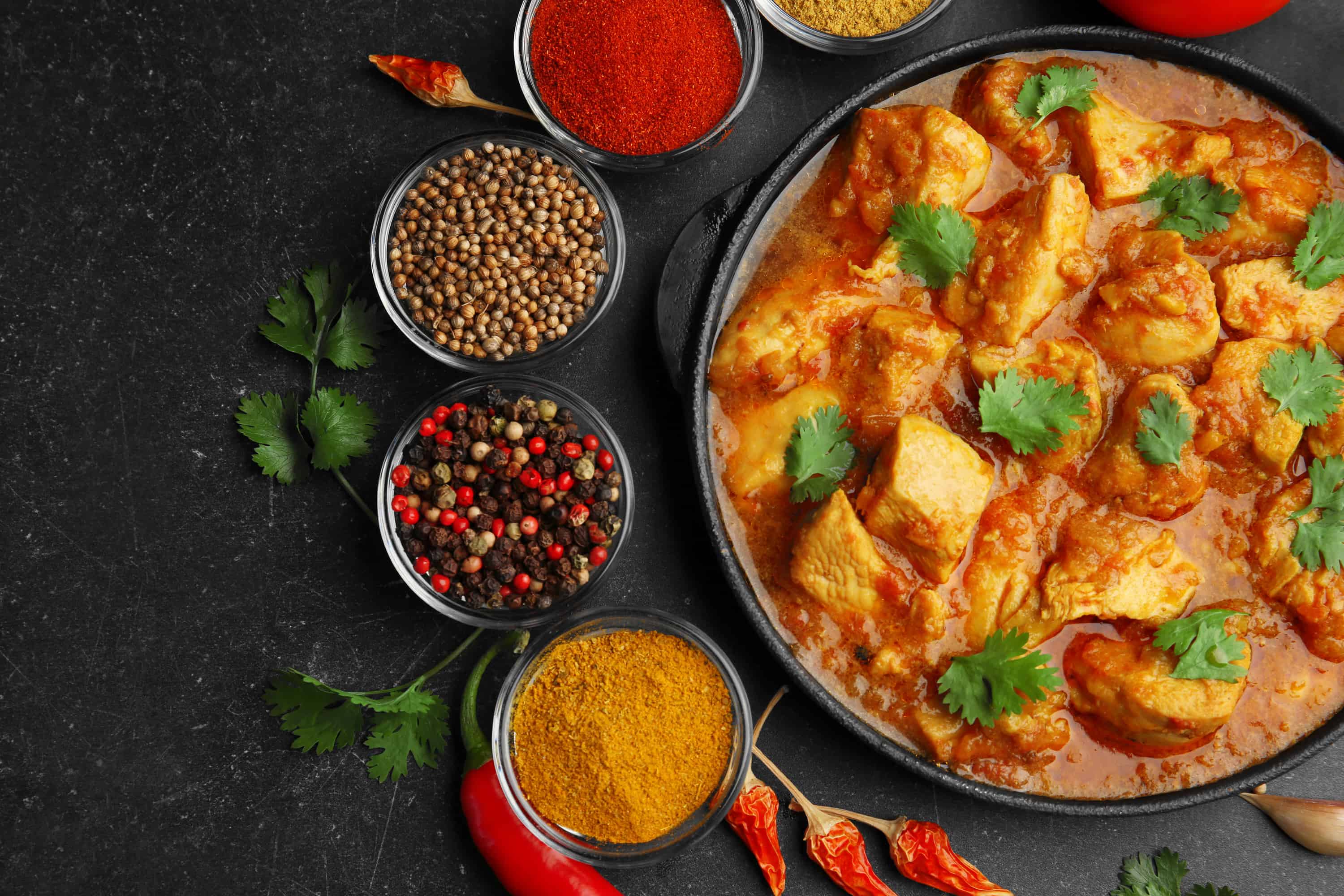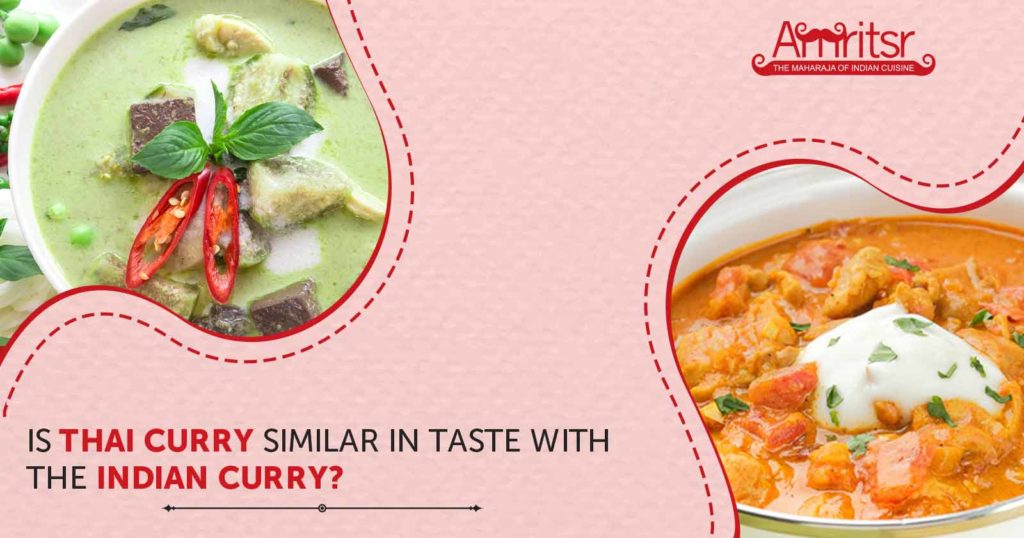Thai Curry Flavor Profile

Thai curry is known for its vibrant and aromatic flavor profile. It is a harmonious blend of various herbs and spices, resulting in a complex and balanced taste. The use of lemongrass brings a refreshing citrusy note, while galangal adds a subtle spiciness. Kaffir lime leaves lend a distinct citrus aroma. Thai curries can range from mild to spicy, depending on the type of curry paste used. The addition of coconut milk provides a creamy and slightly sweet base, enhancing the overall flavor. The combination of these ingredients creates a unique and enticing flavor that is characteristic of Thai cuisine.
Thai Curry: Ingredients And Taste
Thai curry is known for its vibrant and aromatic flavor profile. It is a harmonious blend of various herbs and spices, resulting in a complex and balanced taste. The use of lemongrass brings a refreshing citrusy note, while galangal adds a subtle spiciness. Kaffir lime leaves lend a distinct citrus aroma. Thai curries can range from mild to spicy, depending on the type of curry paste used. The addition of coconut milk provides a creamy and slightly sweet base, enhancing the overall flavor. The combination of these ingredients creates a unique and enticing flavor that is characteristic of Thai cuisine.
Thai Curry: Spiciness Levels And Aroma
Thai curries can vary in terms of spiciness levels, ranging from mild to very hot. The spiciness is usually determined by the type and amount of curry paste used. Red curry tends to be the spiciest, followed by green curry, while yellow curry is milder. The aroma of Thai curry is complex and aromatic, thanks to the combination of herbs and spices used, such as lemongrass, galangal, and kaffir lime leaves. These ingredients contribute to the distinct and enticing fragrance that Thai curries are known for.
Indian Curry Flavor Profile

Indian curries are known for their rich and complex flavor profiles. They are typically made with a blend of aromatic spices such as turmeric, cumin, coriander, cinnamon, and cardamom. These spices create a warm and earthy taste that is often accompanied by a hint of sweetness. Indian curries can range from mild to spicy, depending on the combination and amount of spices used. The use of tomatoes or yogurt as a base gives Indian curries a tangy and creamy texture. Each region in India has its own variation of curries, offering a diverse range of flavors and heat levels.
Indian Curry: Spice Blends And Ingredients
Indian curries are known for their vibrant and aromatic spice blends. The key spices used in Indian curries include turmeric, cumin, coriander, cinnamon, and cardamom. These spices create a warm and earthy flavor that is characteristic of Indian cuisine. Other common ingredients used in Indian curries are ginger, garlic, onions, and tomatoes. The combination of these spices and ingredients gives Indian curries their distinct and robust flavor profile. Each region in India has its own unique spice blend and cooking techniques, adding to the diversity of Indian curry flavors.
Indian Curry: Range Of Flavors And Heat Levels
Indian curry offers a wide range of flavors and heat levels, influenced by the diverse regional cuisines of India. Flavors can vary from mild and aromatic to bold and spicy. The heat levels in Indian curry can also vary, with some dishes being mild and others packing a fiery punch. This range of flavors and heat levels allows for a customized experience based on personal taste preferences. Whether you enjoy a mild and creamy butter chicken or a hot and spicy vindaloo, Indian curry has something to satisfy every palate.
Contrasting Base Ingredients

Thai curry and Indian curry also differ in their base ingredients. Thai curry commonly uses coconut milk as its base, which gives the dish a creamy and milder flavor. On the other hand, Indian curry typically starts with a base of dry spices such as turmeric, cumin, and coriander, along with onions, ginger, and garlic. Indian curries may also include tomatoes, cream, or yogurt in their base. These base ingredients play a significant role in shaping the overall flavor and texture of the curries, adding to the contrast between Thai and Indian cuisine.
Thai Curry: Coconut Milk Base
Thai curry stands out for its distinctive coconut milk base. The creamy and milder flavor of Thai curry is attributed to this key ingredient. The base of Thai curry is made by blending fresh ingredients such as lemongrass, galangal, coriander roots, and shrimp paste with coconut milk. This combination creates a rich and smooth texture, enhancing the overall taste of the curry. The coconut milk not only brings a luscious creaminess but also balances out the spiciness and adds a hint of sweetness to the dish. It complements the aromatic spices and herbs, creating a harmonious flavor profile in Thai curry.
Indian Curry: Tomato Or Yogurt Base
Indian curry is known for its flavorful and rich base, which can be achieved through the use of tomatoes or yogurt. The tomatoes in Indian curry lend a tangy and slightly sweet taste to the dish, while also providing a vibrant red color. On the other hand, yogurt adds a creamy and tangy element to the curry, balancing out the spices and enhancing the overall flavor. Both tomato and yogurt act as a base for the spices and other ingredients, creating a harmonious blend of flavors in Indian curry.
Key Spices And Herbs

Thai Curry: Lemongrass, galangal, and kaffir lime leaves are key spices and herbs in Thai curry. Lemongrass adds a citrusy and refreshing flavor, while galangal provides a unique, spicy, and slightly sweet taste. Kaffir lime leaves contribute a distinct citrusy aroma. These ingredients are essential for creating the vibrant and aromatic flavors that Thai curry is known for. The combination of these spices and herbs creates a harmonious and refreshing taste experience.
Indian Curry: Turmeric, cumin, and coriander are key spices in Indian curry. Turmeric adds a warm and earthy flavor, while cumin offers a slightly smoky and nutty taste. Coriander adds a fresh and citrusy note. These spices, along with other variations such as cardamom, cinnamon, and cloves, are blended together to create the complex and rich flavor profile of Indian curry. They add depth and warmth to the dish, enhancing the overall taste experience.
Thai Curry: Lemongrass, Galangal, And Kaffir Lime Leaves
Thai curry is known for its vibrant and aromatic flavors, thanks to the key spices and herbs used in its preparation. Lemongrass adds a citrusy and refreshing flavor, while galangal provides a unique, spicy, and slightly sweet taste. Kaffir lime leaves contribute a distinct citrusy aroma. Together, these ingredients create a harmonious and refreshing taste experience. Lemongrass adds a zesty and bright note, while galangal adds depth and a hint of heat. Kaffir lime leaves add a refreshing citrusy fragrance. These ingredients are essential for creating the authentic and flavorful Thai curry.
Indian Curry: Turmeric, Cumin, And Coriander
Indian curry is characterized by its aromatic blend of spices, with turmeric, cumin, and coriander being the key players. Turmeric, known for its vibrant yellow color, adds a warm and earthy flavor to the curry. Cumin brings a smoky and slightly bitter taste, while coriander adds a citrusy and fresh note. These spices work together harmoniously to create the distinctive and rich flavors found in Indian curries. The combination of turmeric, cumin, and coriander forms the foundation of many Indian curry recipes, providing depth and complexity to the dish.
Regional Variations

Thai Curry: Red, green, yellow, and Massaman curry are the most popular regional variations of Thai curry. Red curry is made with red chili peppers for a spicier flavor, while green curry uses green chili peppers for a milder yet still aromatic taste. Yellow curry is known for its subtle sweetness and mild spiciness, derived from the addition of turmeric. Lastly, Massaman curry is a rich and hearty curry with Indian influences, including ingredients like cardamom and cinnamon. These regional variations offer a diverse range of flavors and aromas within Thai cuisine.
Thai Curry: Red, Green, Yellow, And Massaman Curry
Red curry, green curry, yellow curry, and Massaman curry are the most popular regional variations of Thai curry. Red curry is known for its fiery and spiciness, made with dried red chilies. Green curry uses fresh green chilies and has a bright and herby flavor from cilantro root and makrut lime leaves. Yellow curry draws on turmeric and dried curry for a rich savory flavor and a vibrant yellow color. Lastly, Massaman curry is milder in heat and incorporates spices commonly found in Indian cuisine, such as cinnamon and cardamom. These variations offer a diverse range of flavors within Thai curry.
Indian Curry: North Indian, South Indian, And Coastal Regional Varieties
Indian curry is not limited to just one style or flavor. In fact, India boasts a wide range of regional variations that offer unique taste experiences.
In North Indian cuisine, curry tends to be rich and creamy with a heavy use of dairy products like yogurt, cream, and ghee. Popular dishes include butter chicken and chicken tikka masala.
In South Indian cuisine, curry is typically spicier and characterized by the use of coconut, tamarind, and curry leaves. Dishes like dosa and sambar showcase the distinct flavors of this region.
Coastal regions of India, such as Kerala and Goa, are known for their seafood curries. These curries often feature ingredients like coconut milk, mustard seeds, and tangy flavors from tamarind or kokum.
The diversity of Indian curry across these regions allows you to explore a variety of flavors, spice levels, and ingredients. Whether you prefer rich and creamy or spicy and tangy, there is an Indian curry to satisfy every palate.
Conclusion

In conclusion, the flavor profiles of Thai curry and Indian curry offer distinct and contrasting experiences. Thai curry is characterized by its bright and vibrant flavors, with a focus on herbs and spices like lemongrass and kaffir lime leaves. Indian curry, on the other hand, showcases a rich and creamy texture with a multitude of spices such as turmeric, cumin, and coriander. The base ingredients also differ, with Thai curry using coconut milk and Indian curry incorporating tomato or yogurt. Whether you prefer the light and fresh taste of Thai curry or the velvety richness of Indian curry, both cuisines offer a wide range of flavors to explore and enjoy.
Comparison Of Thai And Indian Curry Flavor Profiles
Thai curry and Indian curry offer contrasting flavor profiles. Thai curry is known for its bright and vibrant flavors, with a focus on fresh herbs and spices like lemongrass, galangal, and kaffir lime leaves. It has a lighter and fresher taste, with a creamy and mild flavor from the coconut milk base. On the other hand, Indian curry is characterized by its rich and complex flavors, with a variety of spices like turmeric, cumin, and coriander. It has a spicier and bolder taste, with a creamy texture derived from ingredients like tomato or yogurt. The flavor profiles of these curries differ significantly, providing unique and delicious culinary experiences.
Taste Preferences And Pairings
Taste preferences for Thai and Indian curry can vary depending on individual preferences. Those who enjoy bold and complex flavors may gravitate towards Indian curry, while those who prefer fresh and vibrant flavors may lean towards Thai curry. Pairings for Thai curry often include jasmine rice, noodles, or fresh vegetables, while Indian curry pairs well with naan bread, rice, or roti. It is worth noting that both curries can be customized to suit personal taste preferences by adjusting the spiciness levels or adding additional ingredients. Ultimately, the choice between Thai and Indian curry comes down to personal preference and desired flavor profile.
FAQ About Thai Curry Vs Indian Curry: Contrasting Flavor Profiles
Q: What are the main differences between Thai and Indian curry flavors?
A: Thai curries are known for their vibrant and fresh flavors with a balance of sweet, sour, salty, and spicy notes. Indian curries, on the other hand, are richer and heavier with a focus on aromatic spices and creamy textures.
Q: What are commonly used ingredients in Thai curry compared to Indian curry?
A: Thai curries often feature ingredients like lemongrass, galangal, kaffir lime leaves, and coconut milk. Indian curries, on the other hand, tend to use staples like cumin, coriander, turmeric, and yogurt or cream.
Q: How are the spice levels different between Thai and Indian curries?
A: Thai curries are generally spicier and focus on fresh chili peppers for heat. Indian curries use a blend of ground spices which can vary in heat intensity depending on the dish.
Q: Are there differences in the consistency of Thai and Indian curries?
A: Yes, Thai curries are typically more broth-based and have a soup-like consistency, while Indian curries are thicker and often feature a gravy-like sauce.
Q: Which types of meats or proteins are commonly used in Thai and Indian curries?
A: In Thai curry, seafood and poultry are popular choices, while Indian curries often incorporate lamb, beef, or goat in addition to chicken and seafood.
Q: Can vegetarians and vegans enjoy both Thai and Indian curries?
A: Yes, both Thai and Indian cuisines offer a wide variety of vegetable-based curries that cater to vegetarian and vegan diets. Thai curries with tofu and vegetables or Indian curries with chickpeas or paneer are popular choices for plant-based eaters.
Q: Are there regional variations within Thai and Indian curries?
A: Yes, both Thai and Indian cuisines have diverse regional influences that result in a variety of curry styles. For example, Thai green curry is distinct from Massaman curry, just as North Indian butter chicken differs from South Indian coconut curry.

Madame Thai Cuisine is not just a restaurant; it’s a culinary journey through Thailand’s vibrant and diverse flavors. Our story began with a passion for sharing the authentic tastes of Thailand with the world. Situated in the heart of [location], Madame Thai Cuisine has been a beacon of Thai culinary excellence since [year of establishment]. Our commitment to using only the finest and freshest ingredients, combined with traditional cooking techniques, has earned us a reputation as a go-to destination for exquisite Thai dining.